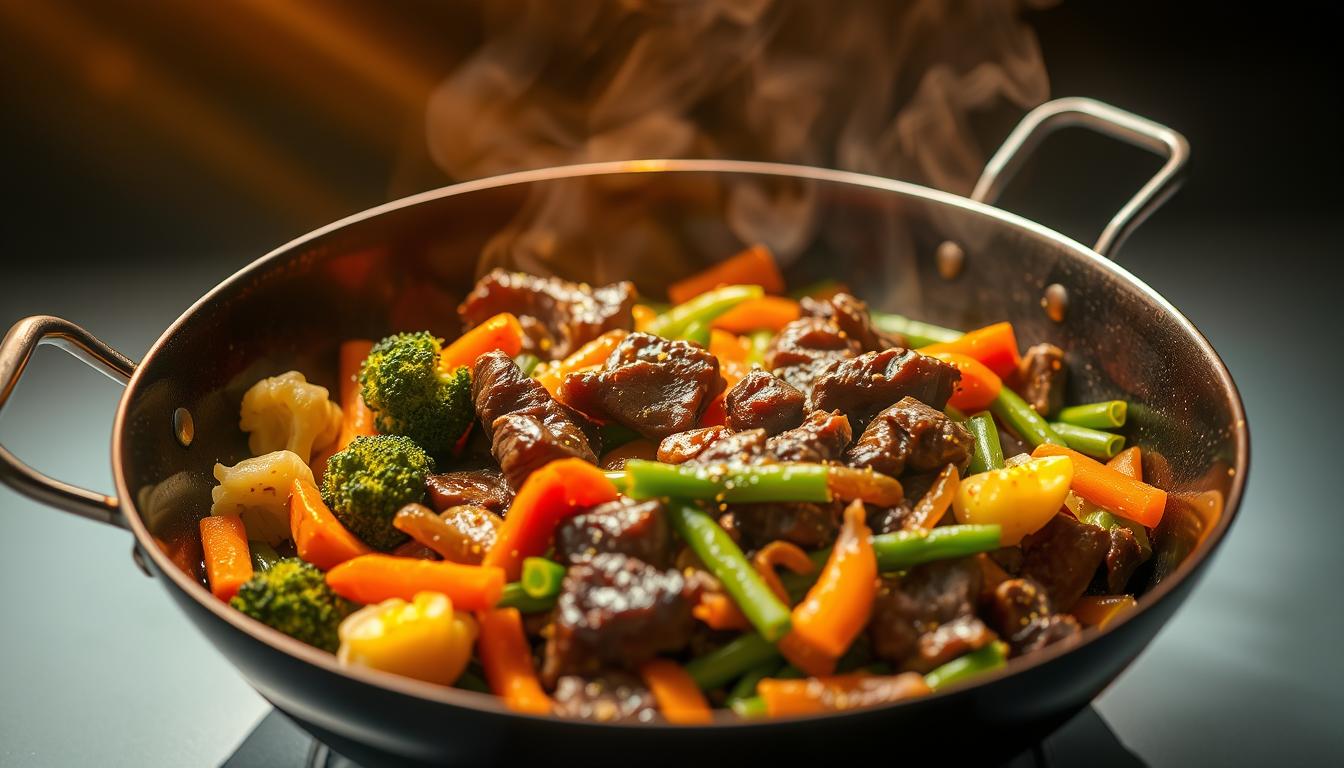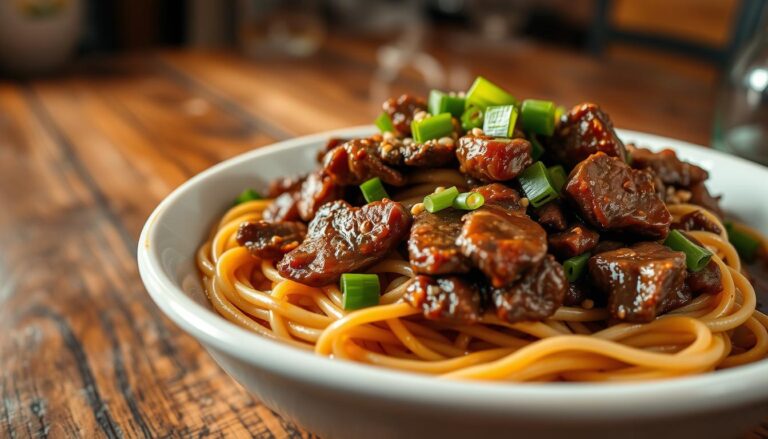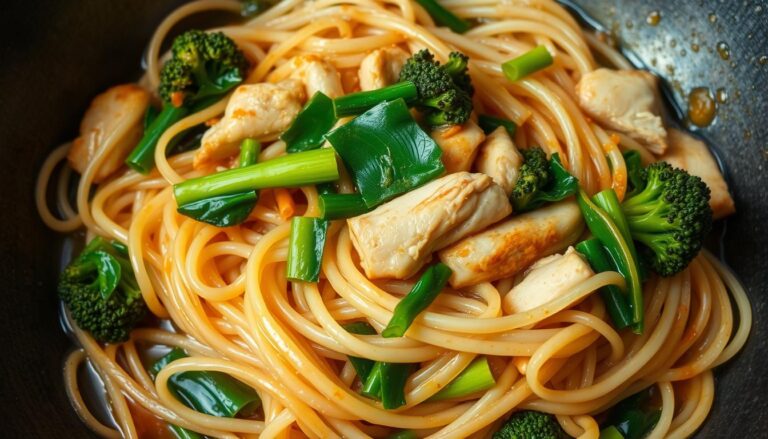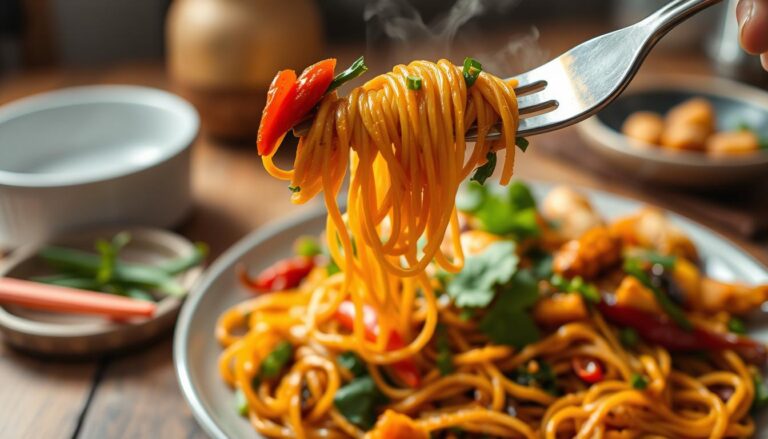Quick and Delicious Beef Stir-Fry with Vegetables
Craving a meal that’s fast, flavorful, and fills your kitchen with mouthwatering aromas? This easy beef stir-fry recipe brings together tender slices of beef and crisp, colorful veggies in under 30 minutes. Perfect for busy weeknights, it’s a dish that turns simple ingredients into something extraordinary.
Inspired by family traditions, this recipe balances speed and taste. The secret lies in marinating the beef to lock in juiciness and using a homemade sauce that adds depth to every bite. A hot pan and quick stir-frying ensure your veggies stay vibrant while the meat stays succulent.
No need for takeout when you can create restaurant-quality flavors at home. We’ll walk you through choosing the right cuts of beef, prepping vegetables for optimal crunch, and layering flavors like garlic and soy sauce. Even better, this dish adapts to whatever veggies you have on hand.
From marinating tips to troubleshooting soggy vegetables, this guide covers it all. You’ll learn how to set aside ingredients for efficient cooking and master the art of building a stir-fry that’s both satisfying and nutritious. Let’s get sizzling!
Key Takeaways
- Cook a restaurant-quality meal at home in under 30 minutes.
- Use marinated beef and fresh veggies for maximum flavor and texture.
- Customize the dish with your favorite vegetables or pantry staples.
- Master layering techniques to avoid soggy or overcooked ingredients.
- Learn how a hot pan and quick stir-frying lock in juices and crunch.
Introduction to Your Weeknight Stir Fry
Transform hectic evenings with a dish that’s as quick as it is delicious. A well-made beef stir fry combines juicy slices of meat with crisp vegetables, creating harmony in every bite. It’s the ultimate solution for nights when you need dinner ready fast but refuse to sacrifice flavor.
Success starts with preparation. Chop your veggies and marinate the beef before heating the pan. This “mise en place” approach ensures everything cooks evenly and quickly. You’ll spend 10 minutes prepping, then just 8-10 minutes actively cooking.
Why does this recipe work so well? High heat sears the meat to lock in juices while keeping vegetables tender-crisp. A splash of oil in a hot pan creates that signature sizzle without greasiness. Customize with broccoli, bell peppers, or snap peas—whatever’s fresh or hiding in your fridge.
Forget takeout menus. With this method, you control the ingredients and flavors. It’s faster than delivery and far more rewarding. Plus, leftovers (if there are any!) reheat beautifully for tomorrow’s lunch.
Ingredients and Their Benefits
Building a standout dish begins with fresh, thoughtfully chosen components. Your stir fry hinges on two essentials: quality protein and crisp produce that work together seamlessly. Let’s break down how each ingredient contributes to flavor, texture, and nutritional value.
Choosing the Right Beef
Opt for top sirloin or flank steak—these cuts stay tender during quick cooking. Thin slicing against the grain ensures each piece absorbs marinade efficiently. Look for meat with fine marbling; this fat melts during frying, adding richness to your beef stir fry.
Exploring a Rainbow of Veggies
Vibrant vegetables like broccoli, bell peppers, and snap peas bring crunch and color. Broccoli offers vitamin C, while red peppers add natural sweetness. Mix textures: soft mushrooms balance crisp carrots. This variety keeps every bite exciting and nutrient-dense.
Simple pantry staples like soy sauce and cornstarch form the base of your seasoning. A pinch of sugar balances salty flavors. Remember to set aside prepped items before heating the pan—this avoids overcooking and keeps flavors distinct.
Prepping Your Ingredients: The Mise en Place Advantage
Ever wonder why restaurant stir fries taste flawless every time? The secret lies in mise en place—a French term meaning “everything in its place.” This method lets you focus on high-heat cooking without scrambling to chop veggies or measure sauces mid-fry.
Start by slicing all vegetables into uniform pieces. Matchstick carrots, broccoli florets, and bell pepper strips should match in thickness. Consistent sizing ensures even cooking—no raw onions or mushy zucchini. Use a sharp knife or mandoline for precision.
Tips for Uniform Vegetable Sizing
Group veggies by cooking time. Harder produce like carrots goes in one bowl, quicker-cooking items like snow peas in another. This organization prevents overcooking delicate ingredients when you add them to the pan in stages.
Dedicate 20-25 minutes to prep work before heating your skillet. Measure sauces, mince ginger garlic mixtures, and arrange everything within arm’s reach. With your ingredients prepped, you’ll achieve that perfect balance of crisp-tender textures and layered flavors.
This approach isn’t just for pros. Home cooks save precious minutes during the cooking frenzy while maintaining control over their fry recipe. Next, we’ll explore how marinating transforms your beef into melt-in-your-mouth perfection.
Marinating and Velveting the Beef
Want restaurant-quality beef in your stir fry? The magic happens before the pan even heats up. Proper marination and velveting transform tough cuts into melt-in-your-mouth morsels that stay juicy under high heat.
Step-by-Step Marination Process
Start with thinly sliced tender beef in a bowl. Add these pantry staples:
- 1 tbsp soy sauce for umami depth
- 1 tsp cornstarch to lock in moisture
- ½ tsp white pepper for subtle heat
- 1 tsp Shaoxing wine (optional for aroma)
Massage the mixture into the meat until sticky. Let it rest 15 minutes at room temperature—this relaxes fibers for even cooking. Never skip the cornstarch; it creates a protective coating during frying.
Understanding the Velveting Technique
Velveting—a Chinese restaurant secret—involves briefly blanching marinated beef in oil or water before stir-frying. This step:
- Seals juices inside the meat
- Prevents overcooking in the main fry
- Gives that glossy, professional texture
For home cooks, marinating with cornstarch mimics this effect. Just ensure your ingredients are prepped and set aside before firing up the stove.
Timing matters. Over-marinating (beyond 30 minutes) can make beef mushy. With your protein ready, you’re set to focus on the stir fry sauce—the flavor powerhouse we’ll tackle next.
Mastering the Stir Fry Sauce
The soul of any great beef stir fry lies in its sauce—a glossy, flavor-packed glaze that coats every ingredient. While store-bought versions work in a pinch, homemade brown sauce elevates your dish from good to “wok hei” perfection.
Homemade Brown Sauce Secrets
Start with a base of beef stock and dark brown sugar for richness. Add depth with oyster sauce and umami punch from soy sauce. Cornstarch acts as the thickening agent, while sesame oil and fresh garlic create aromatic complexity.
Heat oil in your pan until shimmering. Sauté minced garlic until golden—about 30 seconds—to release its nutty sweetness. Pour in your premixed sauce ingredients and stir constantly. The mixture will thicken into a velvety coating in 4-5 minutes.
This technique does three things:
- Prevents clumping through constant stirring
- Distributes heat evenly for consistent texture
- Infuses every bite with savory-sweet balance
Timing matters. Remove the sauce from heat when it coats the back of a spoon—overcooking makes it gummy. Toss your cooked beef and veggies in the sauce just before serving to maintain crispness.
Master this recipe, and you’ll never settle for takeout again. Next, we’ll explore how high-heat cooking techniques lock in these bold flavors.
Cooking Techniques for a Perfect Stir Fry
Your skillet’s smoking hot—now what? Mastering the dance between high heat and precise timing transforms ingredients into a cohesive dish. This method keeps beef succulent while preserving that satisfying vegetable crunch.
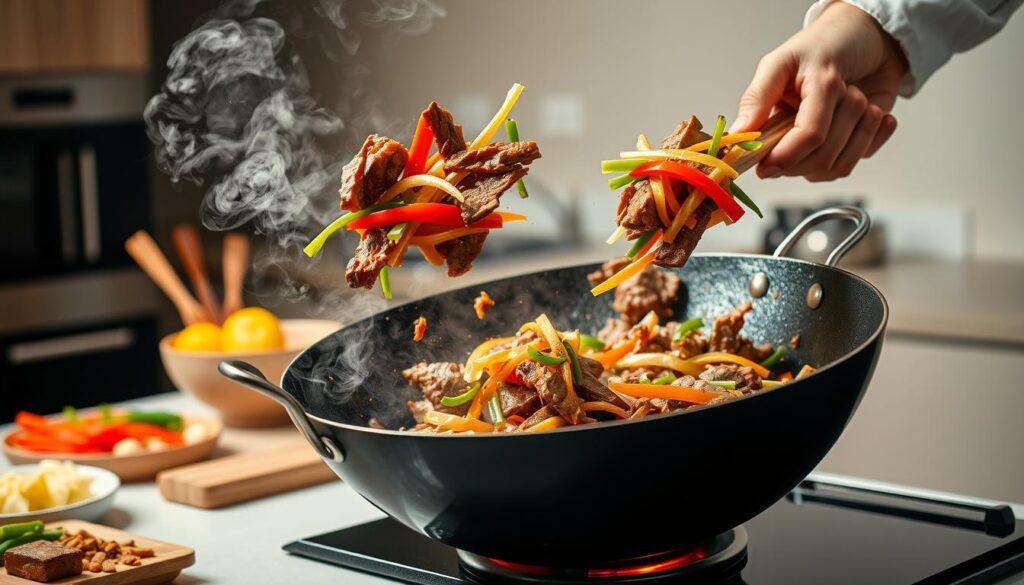
High-Heat Searing for Tender Beef
Preheat your pan until water droplets sizzle and vanish. Add 1 tbsp oil, swirling to coat the surface. Spread beef slices in a single layer—crowding creates steam instead of sear. Let them cook undisturbed for 90 seconds to develop a golden crust.
Flip once, then remove meat immediately. This quick cook time (3-4 minutes total) locks in juices without toughening fibers. Always set aside seared beef before tackling veggies—it prevents overcooking during the next step.
Batch Cooking Vegetables for Even Texture
Reheat the pan before adding veggies in groups. Start with dense options like carrots or broccoli. Stir-fry 2 minutes, then push them to the edges. Toss in quicker-cooking items like bell pepper or snap peas at the center.
This staged approach prevents mushiness. If the pan dries out, add 1 tsp oil between batches. Total vegetable cook time should stay under 5 minutes for optimal crispness.
Troubleshooting tip: If veggies release too much liquid, increase heat and spread them thinly. For undercooked beef, slice pieces thinner next time—they’ll cook faster without burning.
Achieving Flawless beef-stir-fry-with-vegetables Assembly
The moment of truth arrives when sizzling beef meets crisp veggies in a glossy sauce bath. Keep your pan scorching hot—this final step transforms separate components into a unified masterpiece. Swift action here preserves textures and marries flavors.
Return all cooked ingredients to the pan in one bold move. Pour your homemade sauce over the mix, then toss like you’re flipping pancakes. Use wide, confident strokes to coat every piece evenly without crushing delicate bell peppers or broccoli.
Three secrets ensure perfection:
- Maintain high heat to evaporate excess liquid
- Limit stirring to 90 seconds maximum
- Add 1 tsp oil if the mixture sticks
For a complete home meal, fold in pre-cooked rice during the last 30 seconds. Taste and adjust seasoning—a splash of soy sauce boosts saltiness, while honey balances heat. Remove from the burner before components lose their distinct textures.
This assembly isn’t just mixing—it’s the crescendo of your prep work. Proper execution rewards you with tender beef clinging to sauce-kissed veggies, each bite echoing restaurant quality. Master this step, and your fry recipe becomes foolproof weeknight magic.
Serving Suggestions and Meal Prep Ideas
How do you turn a quick stir fry into a memorable meal? The answer lies in creative presentation and smart preparation. Whether you’re plating for guests or prepping for the week, these ideas ensure your dish stays vibrant and flavorful.
Rice, Noodles, and More
Pair your beef stir fry with fluffy jasmine rice for classic comfort. Swap grains for udon noodles to soak up extra sauce. For low-carb nights, serve in crisp lettuce cups—the contrast of warm filling and cool leaves delights the taste buds.
Meal prep becomes effortless when you set aside components. Store chopped veggies in airtight containers for 3-4 days. Mix soy sauce, garlic, and cornstarch in a jar—shake before adding to your pan during cooking.
Garnishing for Extra Flavor and Visual Appeal
A sprinkle of toasted sesame seeds adds nutty crunch. Thinly sliced green onions bring fresh color, while chili flakes offer subtle heat. Drizzle with oil infused with ginger for aromatic depth.
Leftovers? Toss them into omelets or grain bowls for next-day dinner reinventions. With these tips, your stir fry recipe becomes a versatile star—ready to adapt to any schedule or craving.
Troubleshooting and Pro Cooking Tips
Even seasoned cooks encounter hiccups when perfecting their stir fry game. Let’s tackle common challenges and share chef-approved fixes to keep your dinner on track.
Rescuing Texture and Flavor
Soggy vegetables? Crank the heat and spread ingredients thinly. Overcrowded pans steam instead of sear—cook in batches if needed. For undercooked beef, slice thinner next time or flash-fry separately before combining.
Is your sauce too runny? Mix 1 tsp cornstarch with 2 tbsp cold water, then stir into the pan. Too thick? Splash in broth or water while stirring. Always taste before serving—balance salty flavors with honey or brighten with a squeeze of lime.
- Fix blandness: Add ¼ tsp pepper or toasted sesame oil
- Salvage burnt bits: Deglaze with 1 tbsp broth
- Prevent sticking: Use a carbon steel wok or cast-iron skillet
Time management is key. Keep cooked components warm in a 200°F oven while finishing others. Prep seasoning blends beforehand—mix salt, seasonings, and cornstarch in small bowls for quick access.
Pro tip: Double your fry recipe and freeze portions for future meals. Share your creations online—tagging #WeeknightStirFry could inspire others facing similar kitchen adventures!
Conclusion
Imagine serving a restaurant-worthy dish that’s faster than waiting for delivery. This beef stir fry combines tender marinated meat, crisp veggies, and a rich homemade sauce into a 30-minute masterpiece. From slicing against the grain to perfecting that glossy coating, each step ensures bold flavors and satisfying textures.
High-heat cooking locks in juices while keeping vegetables vibrant. Pair it with steamed rice or noodles for a complete meal, and don’t forget the sesame seeds or chili pepper garnish for extra flair.
Got leftovers? They reheat beautifully—making this recipe ideal for busy schedules. Share your creations online and tag us! Questions about substitutions or our comment policy? Drop us a post—we’re here to help.
Mastering this stir fry means turning weeknight dinners into crave-worthy moments. Your skillet’s waiting—let those flavors shine!
FAQ
What’s the best cut of beef for stir fry?
Use flank steak, sirloin, or ribeye for tender results. Slice thinly against the grain to ensure the meat stays juicy during high-heat cooking.
Can I substitute soy sauce in the stir fry sauce?
Yes! Try coconut aminos or tamari for a gluten-free option. Adjust the sugar slightly, as these alternatives may taste sweeter or saltier.
How do I prevent vegetables from turning soggy?
Cook veggies in small batches over high heat. Overcrowding the pan traps steam, which softens them. Crisp-tender texture is key!
What’s the purpose of velveting beef?
Velveting (coating beef in cornstarch and oil) locks in moisture and creates a silky texture. It’s a pro trick for restaurant-quality results at home.
Can I make this recipe ahead for meal prep?
Absolutely! Store cooked beef and veggies separately in airtight containers for up to 3 days. Reheat quickly in a pan to retain texture.
Why is my stir fry sauce too thin?
Thicken it with a cornstarch slurry (1 tsp cornstarch + 2 tsp water). Add it gradually while simmering until the sauce clings to ingredients.
Do I need a wok for this recipe?
A large skillet works too! Ensure it’s heavy-bottomed and preheated properly. High heat distribution is critical for searing.
How can I add more flavor to the dish?
Finish with toasted sesame oil, chili flakes, or fresh herbs like cilantro. A sprinkle of sesame seeds adds crunch and visual appeal.

